Due To Its Long Coastal Area, Gujarat Is More Prone To Imbalances In Hydrological Cycle That Will Result In More Cold And Heat Waves, Says Study
This severe cold wave may have passed and temperatures are expected to normalize by Monday. But the cold weather is here to stay. Researchers suggest that the state’s weather pattern is changing and hence suddenly we are facing an increased frequency of cold waves, heat wave conditions and rise in heavy rainfall.
The latest research on Gujarat’s climate-change conducted by Dr Shital Lodhia, researcher at Sardar Patel Institute of Economic and Social Research, has found that the state is more exposed to extreme weather events and hazards by climate change. The study notes that frequency of extreme weather events (cold wave, heat wave conditions and events of heavy rain fall) and hazards (drought, flood and cyclones) have sharply increased over a period of time, indicating an increased risk.
The research establishes the state’s potential vulnerability towards weather changes, including rise in frequency and severity of cold waves, heat waves and change in rainfall patterns due to imbalances in hydrological cycle.
Dr Lodhia says, “Global warming causes rise in temperatures inducing thermal expansion of ocean which leads to rise in sea level. Gujarat has the longest coastal area, and hence it has maximum damage to bear of these occurrences, unless it timely comes up with effective strategic approach to manage the coastal region in a sustainable manner.”
The research, which has been included in the first issue of 2012 of Management of Environmental Quality, an international journal, establishes that Gujarat is more vulnerable to climateinduced disasters and events of extreme weather, including rise in the incidence of cold waves.
Dr P R Shukla, professor at IIM and author at Inter-governmental Panel on Climate Change, says extreme weather events are on the increase in the state. “Gujarat would be one of the most affected states under climate change when compared to neighbouring states due to its long coastal area,” says Shukla.
COLD COMFORT
Lowest temperature in Ahmedabad this season 5.2 C
Lowest temperature in state (Naliya) 0.8 C
Only one cold wave was recorded in 2010 and none in 2009
Longest cold wave of nine days in January was recorded in 1973 from Jan 21 to 29. The lowest temperature of 4.3°C was recorded on Jan 28, 1973
Longest cold wave of 9 days was recorded in Feb 1974, lowest temperature of 4.8°C was recorded on Feb 7
Economic activities compound problems
The research notes that the state’s coastal region is under tremendous pressure due to rising economic activities and is suffering from degradation of various coastal resources. Further, climate-induced extreme weather events and disasters can worsen the situation. Assumption of sea level rise for Gujarat varies between 15 and 38 cm by mid 21st century. The study shows that the maximum area (1,81,000 hectares) likely to be inundated by sea level rise will be from Gujarat’s coastal area – which means that about 4.4 lakh people in state will be affected by one metre sea level rise.

